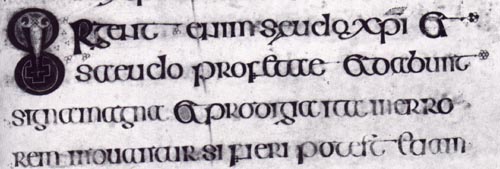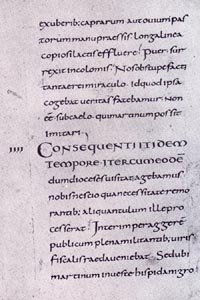ARTH
Courses | ARTH 212
| ARTH 212 Assignments
| Carolingian Culture
Roman and Early Medieval
Scripts:
The Origins of the
Carolingian Scripts
The following are samples of the major
late Roman and early medieval scripts. They present some of the
sources for the origin of Carolingian scripts, especially Caroline
Minuscule.
 |
| Roman Square Capitals:
from a funerary altar of the
1st century A.D. The name Square Capital has been given to the
most formal Roman majuscule script. It was used primarily in
formal inscriptions. See for example the frieze on the exterior
of the Pantheon
or the attic of the Arch
of Titus. It is only rarely found in manuscripts. The extant
manuscripts with square capitals are all copies of Virgil dating
from the 4th or 5th centuries. |
These samples are taken from E. A. Lowe,
Handwriting, Rome, 1969.
 |
| Rustic Capitals: "Medici Vergil", written probably
in Rome before 494 (Florence, Biblioteca Laurenziana 39.1) Rustic
Capitals were the formal bookscript of the Romans. The Vatican
Vergil, a deluxe manuscript from the end of the fourth or
early fifth century, is written in Rustic Capitals. |
 |
| Uncial: New Testament, written probably at Capua about
546 (Fulda, Landesbibliothek I). Perhaps developing in second
half of the third century, the uncial script gains popularity
during the fourth century. Significantly a large number of the
extant uncial texts were Christian manuscripts. Uncial would
supplant the rustic capitals as the most popular script from
the fifth century. |
 |
| Half-Uncial: Augustine (Bamberg, Stasstsbiliothek B. IV).
The half-uncial script was the nearest rival to the uncial script
in popularity from the fifth to the seventh century. |
 |
| Irish Majuscule: Book of Kells, late 8th or early 9th century
(Dublin, Trinity College 58 (A. I. 6)) The Insular scripts, most
especially the Irish Majuscules, were the most distinctive scripts
to develop between the Roman and Carolingian period. Develop
in Ireland, these scripts spread throughout the British Isles
during the Early Middle Ages. They would begin to be replaced
by the Caroline minuscule during the 10th century. |
 |
| Luxeuil Script: Gregory the Great, Moralia, written probably
at the beginning of the eighth century (Verona, Biblioteca Capitolare
XL (38)) Developed in the monastery of Luxeuil, this script developed
as a book script out of the so-called Merovingian Charter script.
This latter script in turn had developed out of the late Roman
cursive scripts. |
Carolingian Scripts
 Sulpicius Severus (Quedlinburg, Gymnasisalbibliothek
79, fol 109v)
Sulpicius Severus (Quedlinburg, Gymnasisalbibliothek
79, fol 109v)
|
 Sulpicius Severus (Quedlinburg, Gymnasisalbibliothek
79, fol 113v)
Sulpicius Severus (Quedlinburg, Gymnasisalbibliothek
79, fol 113v)
|
The samples above come from a ninth century
Carolingian manuscript of a text by Sulpicius Severus. The page
on the left opening a new text is composed of a variety different
scripts, and is a good example of the Carolingian revival of older
forms. From the previous samples, try to identify the different
scripts included on this page. The page on the right except for
the two lines following "IIII" is written in the text
known as Caroline Minuscule. Notice the clear hierarchy of the
different scripts in relationship to the hierarchy of the text.
James J. John, "Latin Paleography,"
in Medieval Studies: an Introduction, James M. Powell,
ed, pp. 21-24: The Caroline minuscule lasted more than four centuries
in its original incarnation and then, largely as the result of
its introduction into printing as the roman type font in the 1460s,
has lasted almost six more centuries since it was revived by the
Renaissance humanists shortly after 1400. Optimists have called
it one of mankind's permanent acquisitions. Other Latin scripts
may have lasted even longer, but no other has so long been so
widely used. The earliest dated surviving examples of the script
are found in a Bible copied at Corbie in the 770s at the order
of Abbot Maurdramm and in some dedicatory verses added to an Evangelistary
copied in the entourage of Charlemagne between 781 and 783.....
[By the early ninth century] the script rapidly spread over all
but the southern extremes of the Carolingian Empire. By the mid-ninth
century, it had supplanted all other text scripts within this
area.... The abbey of Tours, whatever its role in the original
development of Caroline minuscule, played an important part in
this rapid dissemination [the example above is from Tours]....
E.A. Lowe, Handwriting, p. 29: This
new type [Caroline Minuscule] based on half-uncial, whose distinctive
features was the elimination of cursive elements, must have won
the warm approval of Charlemagne and Alcuin. For the school in
which it was to reach its greatest perfection....was the school
directly under Charlemagne's patronage, in the Abbey where Alcuin
was Abbot (796-804) -- the school of St. Martin at Tours....
The orderliness, simplicity, clarity,
and dignity of the new script were virtues that made a special
appeal to a man like Charlemagne, who, as we know, was not above
taking a profound interest in the labours of scribes. To the royal
approbation was added that of Alcuin. He too was in a position
to appreciate the new minuscule, whose special quality of legibility
contrasted so favourably with the eccentricities of his native
Anglo-Saxon hand. This double sanction gave to the script the
greatest possible prestige. Among his other reforms Charlemagne
had ordered a new and standard text of the Benedictine Rule, and
a revision of the Vulgate and the liturgy; and these revised versions,
everywhere in demand, became as it were the apostles and propagators
of the new script. This, then, is the meaning of the so-called
Caroline 'reform.'
ARTH
Courses | ARTH
212 | ARTH 212 Assignments
| Carolingian Culture







